The Culture of Bangladesh refers to the way of life of the people of Bangladesh. It has evolved over the centuries and encompasses the cultural diversity of several social groups of Bangladesh. The Bengal Renaissance of the 19th and early 20th centuries, noted Bengali writers, saints, authors, scientists, researchers, thinkers, music composers, painters, and film-makers have played a significant role in the development of Bengali culture. The Bengal Renaissance contained the seeds of a nascent political Indian nationalism and was the precursor in many ways to modern Indian artistic and cultural expression. The culture of Bangladesh is composite and over the centuries has assimilated influences of Islam, Hinduism, Buddhism, and Christianity. It is manifested in various forms, including music, dance, and drama; art and craft; folklore and folktale; languages and literature; philosophy and religion; festivals and celebrations; as well as in a distinct cuisine and culinary tradition.
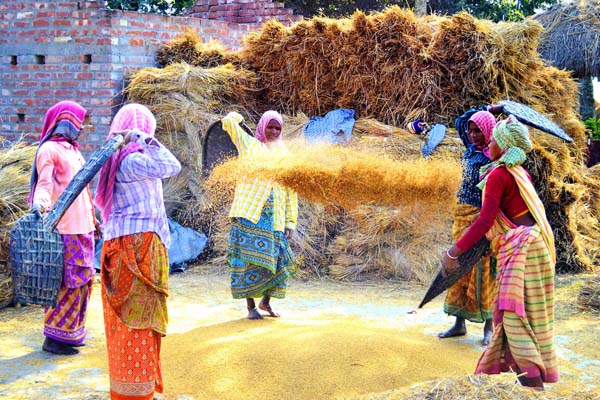
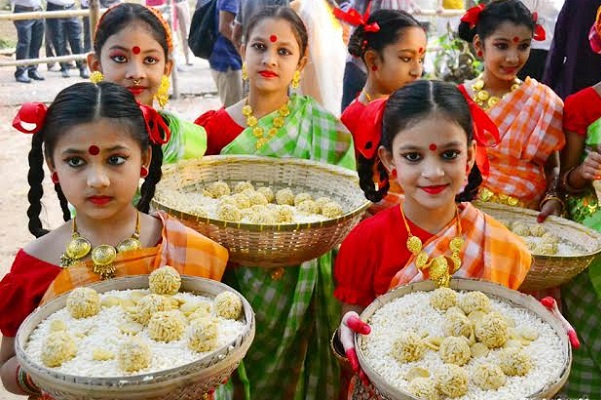
01. Nabanna
The festival is celebrated with mela which are called nabanna mela. It is one of the numerous festivals that gave the name "baro mase tero parban" (thirteen festivals in twelve months ) to the land of Bengal. Although the nabanna parban is somewhat different from other ones since it is not connected to a religion such as Ratha Yatra. The villagers and locals from both the major religious groups join the festival with equal participation. There are also several fertility rituals which make the festival truly a harvest ritual. The festival gets a lot of support from the creative army of Bengali culture. Several poets, musicians, baul and painters flock to such mass gatherings. There is a famous play written on nabanna by Bijon Bhattacharya which depicts the sad incident of the great Bengal Famine of 1943.Nowadays the Festival "Nabanna" is celebrating every Bengali year (1st day of Agrahayan) in Dhaka, organised by Jatiya Nabanna Utshab Udjapan Parshad (National Harvest Festival committee) since 1998. Mr. Shahriar Salam is main planner of the organisation. There are huge number of cultural activists, organisations & performing in a day long festival. Traditional Dance, Song & Rally arranging by the Committee. Once upon a time 1st Agrahayan was the first day of Bengali New Year. It is a non-communal festival in Bengal. people from several villages of Howrah and even from other districts of West Bengal come here. People not only come to visit the Mela. In addition, they participate in many cultural programmes and competitions like 'Pithe Making' (Preparation of different sorts of Bengali Cakes), Seat-and Draw, Senior Citizens' Walking Competition etc. An "Art-Camp" may attract creative minded people where artists from different states will participate. Some rare items of rural Bengal as "Dhenki" (Old-style Domestic Rice Mill), paddy of different varieties directly from the farmers' house are to be exhibited in the Exhibition ground. You can taste some delicious Bengali dishes like Pati-sapta, Payesh (the latest addition is 'Vegetable Payesh'), Jilipipi (not Jilipi) etc. during the festival. Bengal's time-honoured culture and heritage will be presented to you in forms of Baul song, Chhou-dance, Jatra, Tarja, Kobi-gaan, etc. These artists come from different parts of the state to perform their talent and expertise in front of thousands of appreciative gatherings. Moreover, you can refurbish your collection of folk arts from the 'exhibition-cum-sale' stalls of handicrafts made by rural artisans.
02. Ekushey Book Fair
Usually, the fair continues from 1 February to the 28th. It is limited only in Bangla Academy's boundary. The Ministry of Culture is in control of the fair while the Academy does the groundwork. Usually the Prime Minister (or the Chief Adviser in case of Caretaker government) inaugurates the fair. Between 300 and 400 publishing houses takes part. Only the Bangladeshi booksellers can join who have at least 25 books of their own. There is Nazrul Manch, a corner dedicated to poet Kazi Nazrul Islam, a fixed place for month-long cultural meetings, a Lekhok Kunjo, a dedicated place for writers and, a media center for the journalists. Nowadays it became harder to accommodate the huge crowd and the increasing number of publishers. In 2008, the theme of daily conference was 'Bengali Literature and Culture - Achievement of three decades'.
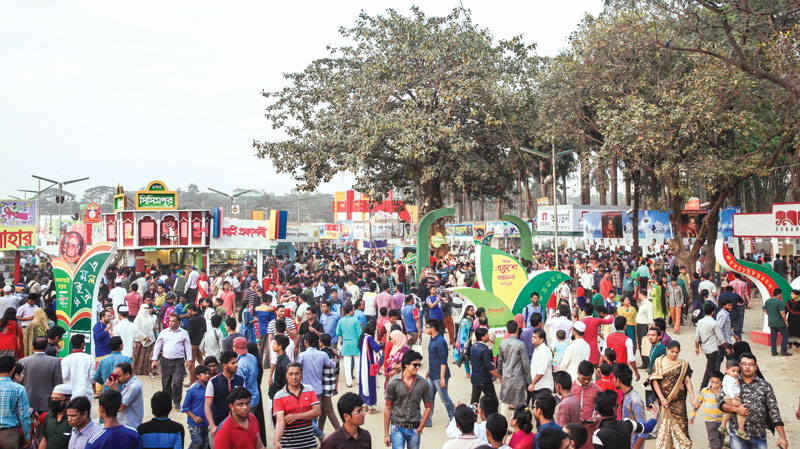
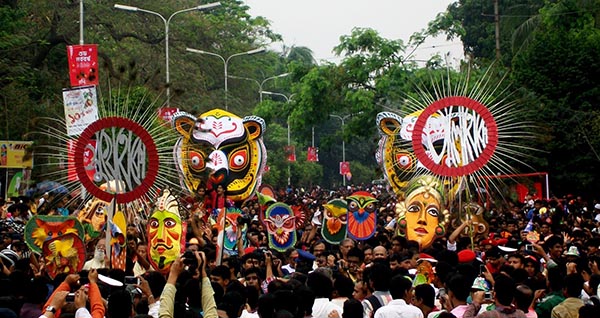
03. Pohela Boishakh
Pohela Boishakh is the first day of the Bengali calendar. It is usually celebrated on 14 April. Pohela Boishakh marks the start day of the crop season. Usually on Pôhela Boishakh, the home is thoroughly scrubbed and cleaned; people bathe early in the morning and dress in fine clothes. They spend much of the day visiting relatives, friends, and neighbours and going to the fair. Fairs are arranged in many parts of the country where various agricultural products, traditional handicrafts, toys, cosmetics, as well as various kinds of food and sweets are sold. The fairs also provide entertainment, with singers, dancers and traditional plays and songs. Horse races, bull races, bullfights, cockfights, flying pigeons, and boat racing were once popular. All gatherings and fairs consist a wide spread of Bengali food and sweets. The most colourful New Year's Day festival takes place in Dhaka.
04. Dhaka International Trade Fair
Dhaka International Trade Fair (DITF) is the biggest, most popular and most vibrant international trade fair in Bangladesh. It is organized by the Export Promotion Bureau together with the Ministry of Commerce of the Government of Bangladesh. Ever since the first fair was inaugurated on 1 December 1995, DITF has been held annually at Sher-E-Bangla Nagar in Dhaka on the west side of Bangabandhu International Conference Centre. The entrance fee is less than US $1. It is open everyday from 10 am to 10 pm and is held from the first week of January to the first week of February every year. Thousands of people visit the fair to enjoy a wonderful day shopping for the finest products from Bangladesh and overseas. In addition to Bangladeshi companies, many companies from around the world participate routinely. There are country specific foreign sections at the fair, which has nearly seven hundred mini-stalls, general stalls, premium stalls, mini-pavilions and mega-pavilions. Lots of local and foreign products are showcased at the fair including electronics, cars, porcelain wares, machinery, carpets, toys, ceramics, fabrics, melamine wares, sanitary products, handicrafts, ready-made garments, home appliances, processed foods, furniture, textiles, plastic goods, jute products, winter clothes, leather goods, cosmetics, sports goods, jewelry, etc.

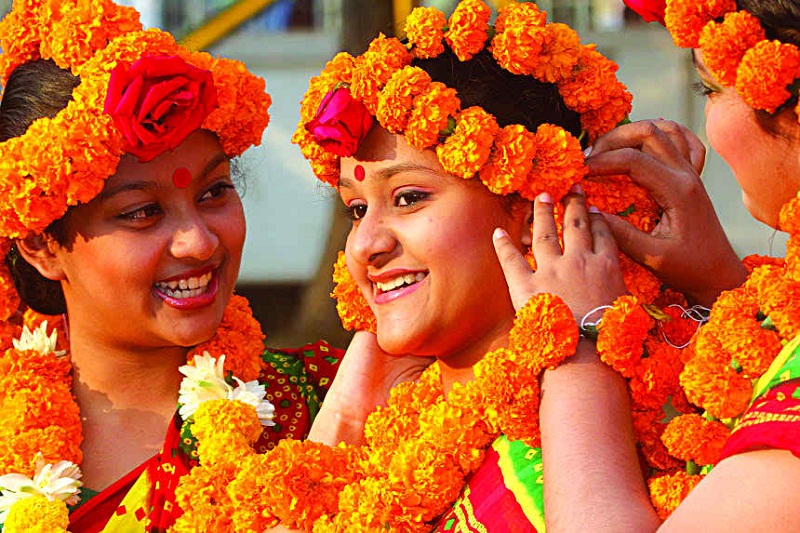
05. Pahela Falgun
Pohela Falgun, the first day of Bengali month Falgun is celebrated in Bangladesh. This day usually falls on 13 February of the Gregorian calendar when the Ekushey Book fair brings a festive mood around the Dhaka University area. Bashanto Utshab festivity, marked by males and females in colourful dresses and decorated with flowers, floods the area on this day and these two festivals together make a grand gathering worthy of enjoying and visiting the site at this particular time of the year. Also, country sides are adorned with flowers including mango flower, shimul and so on and altogether produce eye-catching and soothing landscapes in combination with lush green croplands extended up to the horizon. Nature brings back its lively and colourful essence of life, after the dull and dark winter, through blooming of flowers, trees with green and fresh leaves and chirping of birds. Pohela Falgun holds a special significance to signify love in harmony with natural beauty for prolonging happiness in human life and unfurl their creativity During this time of the year, people usually travel to village homes for enjoying the beauty of nature with their family members including kids. Spring festivity and extraordinary beauty of nature together hold the potential to boost the tourism industry. We can utilise this potential through the implementation of creative tourism product development ideas and the development of tourism resources.






.png)
